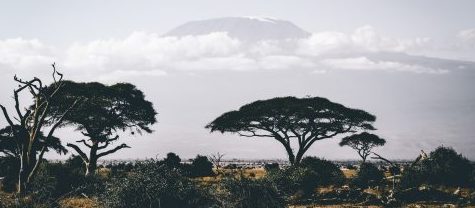In the first blog of this series, we set out a quick overview of the factors that might make Africa the most important continent by the end of this century. We then looked at the social and technological factors that would drive change in Africa. We now turn to Africa’s environmental opportunities and challenges.
There are three key environmental issues for Africa in the decades ahead:
- Climate change and its impact
- The Urban Environment as Africa’s population rapidly grows and migrates to towns, cities and “megacities”
- Africa’s unique natural environment and natural history
Climate Change
The latest IPCC (IntergovernmentalPanel on Climate Change) projections make worrying reading for Africa. They warn that temperature of 1.5% or 2% above pre-industrial global temperatures will adversely affect yields of maize, rice, wheat and other staples, and sub-Saharan Africa will be more prone to extreme temperatures and/or heatwaves.
More specifically, in Western Africa and the Sahel, the IPCC sees a projected increase in the likelihood of periods of drought. In Southern Africa also, it predicts lower rainfall over Namibia, Botswana, Northern Zimbabwe and Southern Zambia. In East Africa, the IPCC takes the view that rainfall may be higher in Somalia, but lower in Ethiopia.
The possibility of an increased frequency in adverse weather events, such as the typhoons that recently hit Mozambique, will further test Africa’s ability to respond and increase its resilience in the face of environmental challenges.
In a worst case, adverse impacts of climate change could see as many as 86 million migrants seeking to escape affected areas. To put this in perspective, in 2018 there were estimated to be 258 million migrants across the whole world.
Taken together these projections increase the risk of major disruption at a time when, all other things being equal, Africa would be growing and thriving as its population increases and the innovation it has already shown in technology continues to progress. Africa’s lack of infrastructure will make it harder to respond to natural disasters, as compared with, say North America or East Asia. Whilst there is a very rapid and widespread expansion under way of African infrastructure, which we will look at in the next blog in the series, Africa faces a major challenge in becoming more resilient.
In responding to the challenge, Africa will not only need to develop a stronger infrastructure, but innovate, for example in using different strains of cereal crops that are more resilient and/or better adapted to the changing natural environment.
It is manifestly in the interests of the rest of the world to assist Africa in its climate change and development goals. At the most basic level, Europe cannot handle unconstrained refugee flows; at the economic level, Africa represents a massive market to sustain future global growth. We see the realisation of these interests, and their embedding in the body politic of the West, to be highly important in providing funding and opportunities for Africa’s development; whilst at the same time being most subject to the resurgent populism currently enveloping the democratic world.
The Urban Environment
By 2050, the African population will be 2.4 billion, and, more strikingly, one third of the world’s youth population will be African, according to a report prepared for the EU Institute for Security Studies (ISS). This growth will be greatest in West, Central and East Africa. By the end of the 21stCentury, Africa’s population is projected to be over 4.1 billion. It will be the most populous continent on earth.
Today 60% of Africa’s population is rural. Urbanisation though will mean that this century’s massive population growth will inevitably see the rise of African megacities. By 2050, four of the world’s 20 most populous cities will be in Africa: Kinshasa (35 million), Lagos (32.6million), Khartoum (16 million), and Dar-es-Salaam (16 million).
Given the absence of modern infrastructure, the rapid growth of these cities presents an obvious and huge challenge to African governments. Will urban planning be possible? Dar-es-Salaam is seeking to apply planning, zoning, transport, sanitation, ensuring access to water, and tackling vulnerability to flooding.
As part of its Belt & Road investment in Africa, China will have plenty of practical advice on building cities. But the sheer pace of growth, the existence of rich and powerful vested interests, and the natural tendency of rural migrants to cluster together in shanty towns for reasons of economy and mutual protection make it likely that much of Africa’s urbanisation will be a crowded and chaotic journey.
However, as noted in previous blogs, urbanisation will also unleash Africa’s flair for innovation, for example in the use of technology. Africa’s evolving megacities will be interesting places, if not quiet ones.
Africa’s Natural Environment
Africa’s unique natural environment is under threat as never before. The struggle to protect species such as the African elephant and rhinoceros from poachers and trophy hunters has been documented for decades, as has the threat to primate species caught up in war zones, such as mountain gorillas in the Central African Highlands, or bonobos in the Democratic Republic of Congo. The International Union for Conservation of Nature (IUCN) declared lions to be vulnerable in 1996, and the African Wildlife Foundation reports a 43% decline in Africa’s lion population in the last 21 years, with lions “regionally extinct” in 15 countries.
There is much positive work being done to try to combat this:
- the recruitment of local people as guardians of their own local environment,
- sustainable land use,
- innovative use of technology in tracking and protection,
- breeding programmes,
- the economic benefits of eco-tourism, and
- the use of social media and other campaigning tools to dissuade trophy hunters and others who provide a market for poached animals and their parts.
However, Africa’s projected rapid population growth, potential environmental challenges from climate change, and rapid infrastructure development will all add to the pressure on Africa’s natural environment. Even if population growth centres on cities, the market for exploiting Africa’s wildlife through smuggled goods may increase.
There will be local disputes to be resolved as farmers affected by climate change, seek to move closer to nature reserves and/or animals seek to migrate from areas affected by drought.
As well as harnessing local efforts to protect the environment, the desire to manage and conserve will also be an international one, which will provide an opportunity for regional and pan-African collaboration and sharing of knowledge.
Watch This Space
In the next blog in this series we look at Africa’s economy, surveying what is driving change, and how Africa might take off into sustained growth in the coming decades.
Written by David Lye, SAMI Fellow and Director
The views expressed are those of the author and not necessarily of SAMI Consulting.
SAMI Consulting was founded in 1989 by Shell and St Andrews University. They have undertaken scenario planning projects for a wide range of UK and international organisations. Their core skill is providing the link between futures research and strategy.
If you enjoyed this blog from SAMI Consulting, the home of scenario planning, please sign up for our monthly newsletter at newreader@samiconsulting.co.uk and/or browse our website at http://www.samiconsulting.co.uk


